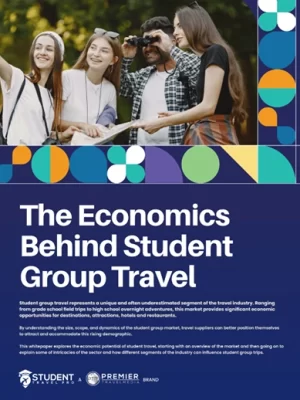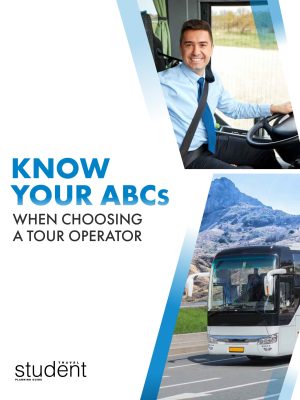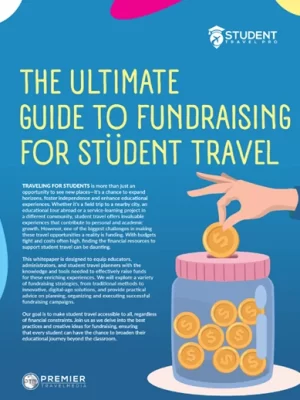Why the Northeast’s “Big Five” are necessary field trip destinations for unparalleled learning opportunities
By Kristy Chan
Imagine vast halls showcasing art, science, history, and other fascinating educational displays. At the Met, take a journey through ancient civilizations; the Smithsonian lets visitors enjoy hands-on scientific discoveries, including replicas of complex rockets; the American Museum of Natural History (AMNH) features a T. Rex skeleton twice your height; Harvard’s cabinets display minerals that sparkle under museum lights; and at Yale Peabody, participatory fossil-dig stations await visitors. The Northeast’s “Big Five” offer diverse exhibits, activities and exciting student programs that captivate learners.
Planning a student trip? Download the latest issue of Student Travel Pro for expert insights, top destinations, and essential planning tips—all for free!
 The Metropolitan Museum of Art (NYC)
The Metropolitan Museum of Art (NYC)
The Metropolitan Museum of Art in New York City is home to America’s largest art museum and the third-largest museum in the world. Visiting the Met requires careful planning, as it’s challenging to see everything in a single trip. This is where the Met student tour comes in, helping you plan a trip that aligns with your curriculum and highlights key pieces throughout history that will fascinate and inspire your students.
- Fees for Group Admission: $12 per student, $28 per adult
- Fees for Guided Tour: $250 admission plus a flat fee per 25 people for a one-hour tour
- Submit a Group Visit Request Form at least three weeks in advance to arrange engaging, hour-long art or history-themed tours
- Pro-Tip: Enjoy free admission for New York City schools, with a standard of one adult accompanying every ten students!
Smithsonian Complex (Washington, D.C.)
The Smithsonian Institution, which embodies the true definition of public knowledge, sees over 30 million visitors each year without any admission fees. Located in Washington, D.C., 21 museums and the National Zoo invite student groups to explore exciting exhibits, many of which are situated along the National Mall. More than 157 million objects, ranging from fascinating dinosaur fossils to inspiring space capsules, provide a trip across multiple museums, perfect for students to discover knowledge on any subject. To beat the crowds, here are some Smithsonian field trip tips:
- Shortlist a few museums to visit; find the list of sites that require a pass here.
- Reserve weekday morning slots 4-6 months in advance.
- Download standards-aligned teacher packets to navigate the many floors.
- Plan around off-peak times, which are generally Mondays through Wednesdays.

American Museum of Natural History (NYC)
Housing the world’s largest collections of natural wonders, the American Museum of Natural History in New York City is particularly great for younger students who may want a more visual learning experience. Students don’t need to look far to see gigantic displays of dinosaurs, meteorites, crystals, and a life-sized blue whale hall. The American Museum of Natural History is also known for its comprehensive educational materials, including planning tools and YouTube videos. Some pro-tips to start using their sources are as follows:
- If you are not based in New York City, there is an admission fee starting at $12 per person.
- Adding activities such as the giant-screen film, Space Show, and Invisible Worlds immersive experience will raise the cost per person to $19.50.
- Use the field-trip tool and planning video linked in the educator materials to shorten the prep-time hunt.
- Download the American Museum of Natural History Explorer app or visit the website to find real-time directions and exhibit information, so you always know your next step.
 Harvard Museums of Science & Culture (Boston)
Harvard Museums of Science & Culture (Boston)
The Harvard Museums of Science & Culture unite four world-class collections under one roof, providing students with the opportunity to explore a diverse range of exhibits, from dazzling mineral specimens to the story of human evolution and the mysteries of ancient civilizations. The museums include the Collection of Historical Scientific Instruments, Harvard Museum of the Ancient Near East, Harvard Museum of Natural History, and the Peabody Museum of Archaeology & Ethnology. With exhibits designed to spark curiosity and connect directly to classroom learning, this is a field trip that blends Ivy League-caliber education with hands-on discovery. To make the most of your visit, here are some Harvard field trip tips:
- Pre-reserve your field trip group to receive $3 standard admission (originally $10 per student and $15 per adult).
- Visit on days when all museums are open to make the most of your visit, which is every day except Saturdays.
- Explore virtually with 50-minute online field trips for middle schoolers, perfect for snow days or remote learning.

Yale Peabody Museum (Connecticut)
Described as a “museum for a modern world,” the Yale Peabody Museum is highly accessible to everyone, regardless of mobility, education or income. Located in New Haven, Connecticut, this museum invites the public and Yale community to explore, create and build lifelong memories. For grades 2-8, learning styles and curricula can differ significantly, so being able to split the groups into guided tours and workshop sessions offers a range of flexibility and specificity for teachers to encourage students at their own comfort level.
This K-12 science workshop museum visit should be an accessible way to connect classroom learning with real-world discovery. Reserving at least three weeks in advance allows you to receive free admission, making trip planning even easier. Additionally, there are a range of other tips and tricks that can help.
- Select at least one workshop option from “Animal Adaptions,” “Geologic Time,” “Impacts of Climate Change,” “Rocks & Minerals,” and “Ancient Explorers,” and curate a mini-exhibit or see scientific samples up close.
- Locate key exhibits and fill out required forms on the Peabody Pre-Visit Field Trip Information Packet.
- Admission is always free for all visitors, but school groups account for parking, transportation and meal costs.
 Booking & Prep Cheat-Sheet
Booking & Prep Cheat-Sheet
It’s important to have actionable planning intel when deciding which of the student programs at the Northeast’s “Big Five” major museums best suits your curriculum, so here are some last things to consider when selecting a museum.
The Met requires requests three weeks in advance and offers free entry to NYC schools, but adult-to-student ratios are strictly enforced. The Smithsonian’s popular sites—Air & Space and NMAAHC—are free, but timed passes must be booked 4–6months in advance. Using a checklist to plan for access, lunch logistics, and headcount caps will help your visit go smoothly.
Prep Checklist
- Book early: Met (3 weeks), Smithsonian (4–6 mos. for passes), AMNH (5 weeks), Harvard (2 weeks), Peabody (3 weeks).
- Verify chaperone ratios: most require one adult per 10 students.
- Reserve lunchroom slots or plan picnic alternatives.
- Align museum student programs with curriculum standards and learning objectives.

FAQs Teachers Ask
1. Are guided tours worth the fees? Self-guided visits are more budget-friendly and require less paperwork, but guided tours provide structure and access to exclusive student programs, allowing for deeper exploration with a specialist. This is especially noticeable at large museums like the Met, which houses over a million artworks.
2. Can I pay with a purchase order (PO)? Yes, most of the “Big Five” museums will accept POs, though this can vary when and how the payment is paid, so be sure to check out the resources linked below and the sales office!
3. Will my state standards be met? Yes, many student programs and education packets from museums will offer Next Generation Science Standards (NGSS) teaching materials.
4. Are there discounts or free options for schools? It depends on the museum, but generally, there are free admissions and discounts available based on factors like your school’s location, group size, and booking time.
No matter which of the Big Five you choose to explore, your students will uncover fascinating lessons through dynamic experiences. From brilliant artworks and creative pieces to science and history exhibits that wow groups, field trips to these iconic institutions ignite curiosity and a lifelong love of learning.
Make every student trip unforgettable! Sign up for our free newsletter and get travel inspiration, budgeting tips, and expert planning resources.










